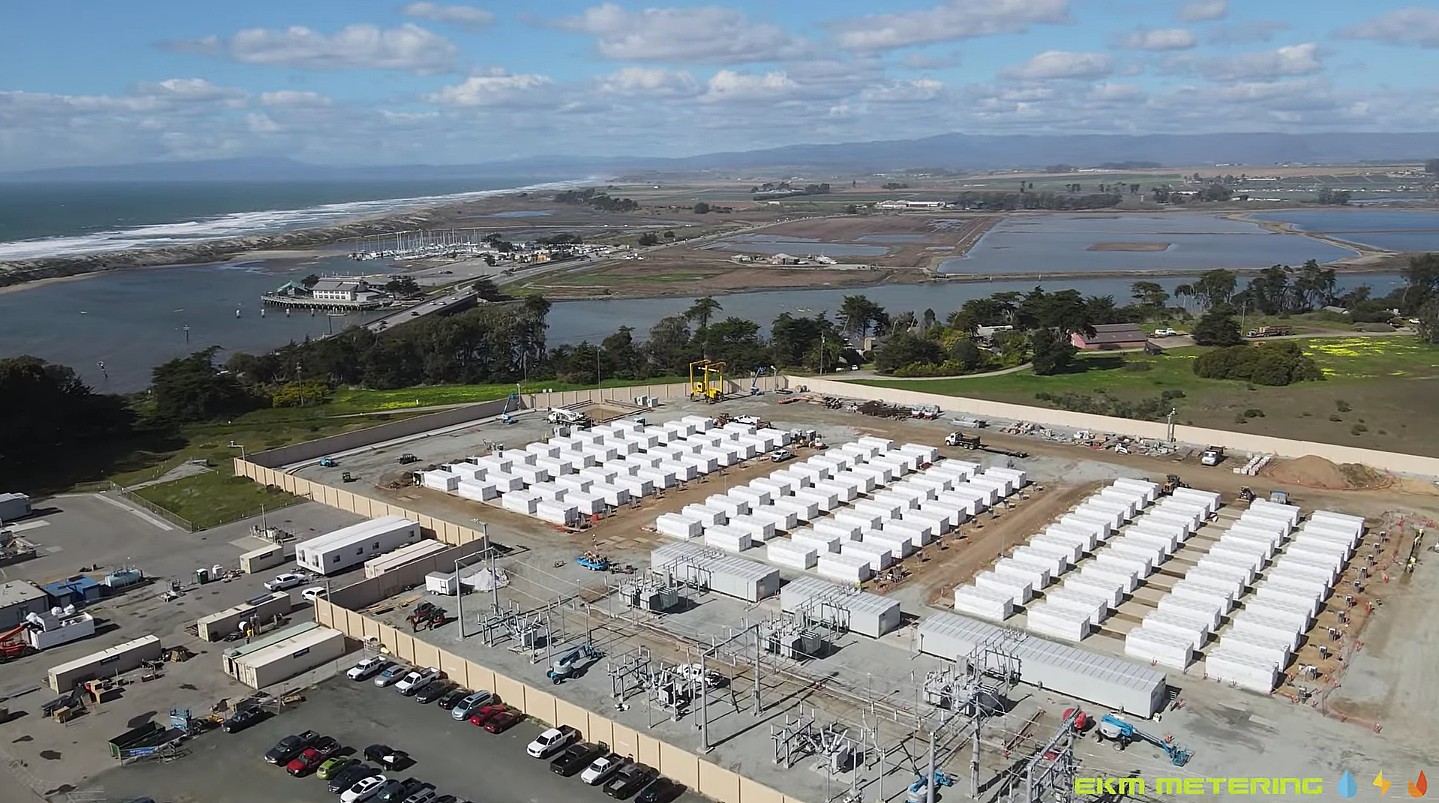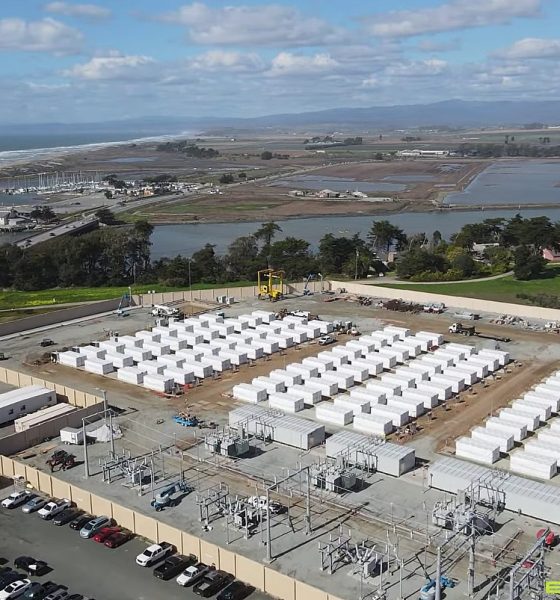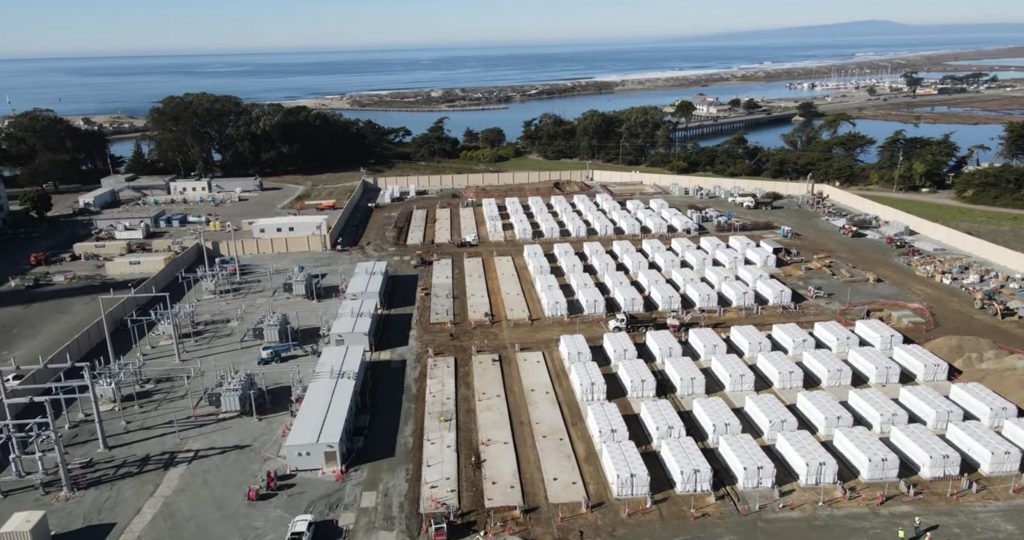

Energy
Tesla’s giant Moss Landing Megapack battery storage project: How is it doing now?
Tesla’s Megapack farm in Moss Landing, California, has gone through quite a journey since the project was approved by the California Public Utilities Commission back in 2018. Comprised of 256 Megapacks, the 182.5 MW / 730 MWh installation would be capable of powering an estimated 136,500 homes for several hours during periods of high demand. The system is also upgradeable, with Tesla’s contract with PG&E suggesting that the battery could be ramped to 1.1 GWh in the future.
Similar to Tesla’s other high-profile energy projects, the Moss Landing Megapack farm, also known as the Elkhorn Battery Energy Storage Facility, would enhance the grid’s reliability by addressing capacity deficiencies due to increased local energy demand. It would also participate in the California Independent System Operator (CAISO) markets, providing both energy and ancillary services.
A Quick Background
It should be noted that the Megapack-powered Elkhorn Battery Energy Storage Facility is only one of four battery projects that were proposed by Pacific Gas and Electric (PG&E). Among the four, three are owned and operated by a third party — only the Tesla-powered Elkhorn Battery is owned and operated by PG&E itself. As explained by Paul Doherty, a PG&E spokesperson, the utility has two underlying contracts with Tesla regarding the facility — an Engineering, Procurement and Construction (EPC) agreement to build the battery farm, and a Long-Term Performance and Maintenance Agreement (LTPMA) that requires the EV maker to provide regular maintenance to the system for over 20 years.
The Tesla-powered Elkhorn Battery is not the largest battery among the four systems proposed by PG&E. That honor goes to the Vistra Energy Storage Facility, which features a 300 MW / 1,200 MWh Phase 1 and a 100 MW / 400 MWh Phase 2 system. Unlike the Tesla Megapack farm, which was built on a 4.5-acre plot of land in Moss Landing, the Vistra Energy Storage Facility was built into what was previously a gas-fired power plant. Utilizing over several thousand TR1300 battery racks supplied by LG Energy Solution, Vistra’s big battery was a symbol of the change happening in California’s energy sector.
Things, however, have not always been smooth sailing.

Challenges Over the Years
Being a project involving Tesla, it was no surprise that entities emerged to oppose the Elkhorn Battery project. After the Tesla-powered battery storage project was opened to public submissions about its potential environmental impacts, the California Unions for Reliable Energy took it upon themselves to stop the initiative. The union argued that Monterey County failed to meet the standards of the California Environmental Quality Act since the county should have looked further into the possibility of Tesla’s batteries overheating and exploding. The group also warned that the Tesla batteries could potentially harm the purity of the groundwater at the Moss Landing area.
These efforts proved to be in vain, however, as on February 2020, the Monterey County Planning Commission decided to approve the Tesla Megapack-powered Elkhorn Battery unanimously. Construction was set for late March, and expectations were high that it would take about one and a half years to complete. However, another speed bump for the project came in the form of the Covid-19 pandemic, which caused progress in the project to be delayed. Construction ultimately began in July 2020, and by early 2021, drone flyovers of the site showed that the Megapack installations were going smoothly.
PG&E spokesperson Doherty has informed Teslarati that as of writing, all the Tesla Megapacks have been successfully installed. The system is “currently undergoing final testing and certification, and is anticipated to be operational before Summer 2022,” pending the results of its final tests. Granted, this represents a delay from the facility’s initial targets, but PG&E’s apparent intent on being extra cautious is understandable.
An unexpected challenge for the batteries at Moss Landing came sometime last year, and while it did not involve the Tesla Megapack-powered Elkhorn Battery, it did result in energy storage projects being placed under a microscope. In early September 2021, a number of battery modules from the Phase 1 area of the Vistra Energy Storage Facility overheated, triggering the facility’s sprinkler systems. Local fire crews were sent to the site, and Vistra decided to shut down the Phase 1 zone until an investigation was completed. At this time, the Vistra Battery’s 100 MW / 400 MWh Phase 2 was just completed, so that part of the facility remained operational.
Unfortunately, the Vistra Battery’s Phase 2 area got involved in another overheating incident in February 2022. Similar to the incident in September 2021, the batteries in the Vistra facility’s Phase 2 area triggered a fire alarm. The local fire department attended to the facility once more, where they found roughly ten battery racks that were melted. This incident, which happened within five months since the September 2021 issue, caused the reactivation efforts for the Phase 1 area to be paused and Phase 2 to be shut down. This meant that the Vistra battery, at least until investigations are completed for both incidents, will likely remain offline.

PG&E’s Tesla Megapack Management System
What is rather interesting about the Elkhorn Battery Energy Storage Facility is the fact that while it features Tesla’s flagship battery storage units, the Megapack batteries themselves would not be managed by software from the electric vehicle maker. Instead of Tesla’s Autobidder platform, PG&E has opted to utilize “Fluence’s AI-powered Trading Platform to provide optimization and market bidding services,” confirmed Doherty.
Tesla’s Autobidder platform has been successfully operating at the Hornsdale Power Reserve (HPR) in South Australia, where it has effectively added competition to drive down energy prices in the area. But inasmuch as Autobidder is designed to work seamlessly with products like the Megapack, Fluence’s Trading Platform is pretty powerful and capable on its own. Seyed Madaeni, the chief digital officer of Fluence, expressed his optimism for the company’s AI-powered solution and its use in the Tesla-powered Elkhorn Battery Energy Storage Facility.
“PG&E was one of the first utilities to appreciate the need for a sophisticated AI-enabled bidding technology to optimize its energy storage assets. This technology-agnostic software provides PG&E with a single tool that can optimize not only the Moss Landing project, but potentially entire portfolios of generation and storage resources to enhance affordability of resources. We are excited to work with PG&E to use advanced technology to improve the efficiency and reliability of the CAISO market and lower costs for California consumers,” Madaeni said.
Future Expansions
While the Moss Landing batteries have faced their own fair share of challenges, PG&E remains extremely optimistic about energy storage as a whole. Depending on the success of the Tesla Megapack-powered Elkhorn Battery, the system could be expanded even further to 1.1 GWh. All signs seem to be pointing to this scenario, especially considering the state’s intense focus on sustainability. Interestingly enough, Tesla’s Megapacks courted some controversy themselves last year when one unit in the Victoria Big Battery in Australia caught fire during tests. The incident ultimately damaged two Megapack units, and it incited a lot of skepticism over the potential dangers of battery storage technology.
If PG&E’s massive Tesla Megapack farm could prove itself as reliable as the now-iconic Powerpack-powered Hornsdale Power Reserve in South Australia, then the project could potentially accelerate the adoption of battery storage systems in the near future. PG&E definitely seems to be confident about the potential of battery storage solutions, with the utility moving forward with Vistra on plans to expand the Vistra Battery even further.
Vistra spokesperson Meranda Cohn has stated that the incidents from September 2021 and February 2022 would not impact the companies’ push to move forward with its battery project. PG&E spokesperson Doherty was on the same page, telling the Monterey County Weekly that he has “full confidence” in the project and that an analysis of the incidents in September 2021 and February 222 revealed that the batteries were actually not at fault. The PG&E spokesperson further noted that the utility is committed to “advancing the field of fire safety at battery storage facilities,” which could be highlighted by the fact that it was awarded for its fire safety work at its Tesla-powered Elkhorn Battery Energy Storage Facility.
Don’t hesitate to contact us with news tips. Just send a message to simon@teslarati.com to give us a heads up.

Cybertruck
Tesla updates Cybertruck owners on timeline of massive feature yet to ship

Tesla is updating Cybertruck owners on its timeline of a massive feature that has yet to ship: Powershare with Powerwall.
Powershare is a bidirectional charging feature exclusive to Cybertruck, which allows the vehicle’s battery to act as a portable power source for homes, appliances, tools, other EVs, and more. It was announced in late 2023 as part of Tesla’s push into vehicle-to-everything energy sharing, and acting as a giant portable charger is the main advantage, as it can provide backup power during outages.
Cybertruck’s Powershare system supports both vehicle-to-load (V2L) and vehicle-to-home (V2H), making it flexible and well-rounded for a variety of applications.
However, even though the feature was promised with Cybertruck, it has yet to be shipped to vehicles. Tesla communicated with owners through email recently regarding Powershare with Powerwall, which essentially has the pickup act as an extended battery.
Powerwall discharge would be prioritized before tapping into the truck’s larger pack.
However, Tesla is still working on getting the feature out to owners, an email said:
“We’re writing to let you know that the Powershare with Powerwall feature is still in development and is now scheduled for release in mid-2026.
This new release date gives us additional time to design and test this feature, ensuring its ability to communicate and optimize energy sharing between your vehicle and many configurations and generations of Powerwall. We are also using this time to develop additional Powershare features that will help us continue to accelerate the world’s transition to sustainable energy.”
Owners have expressed some real disappointment in Tesla’s continuous delays in releasing the feature, as it was expected to be released by late 2024, but now has been pushed back several times to mid-2026, according to the email.
Foundation Series Cybertruck buyers paid extra, expecting the feature to be rolled out with their vehicle upon pickup.
Cybertruck’s Lead Engineer, Wes Morrill, even commented on the holdup:
As a Cybertruck owner who also has Powerwall, I empathize with the disappointed comments.
To their credit, the team has delivered powershare functionality to Cybertruck customers who otherwise have no backup with development of the powershare gateway. As well as those with solar…
— Wes (@wmorrill3) December 12, 2025
He said that “it turned out to be much harder than anticipated to make powershare work seamlessly with existing Powerwalls through existing wall connectors. Two grid-forming devices need to negotiate who will form and who will follow, depending on the state of charge of each, and they need to do this without a network and through multiple generations of hardware, and test and validate this process through rigorous certifications to ensure grid safety.”
It’s nice to see the transparency, but it is justified for some Cybertruck owners to feel like they’ve been bait-and-switched.
Energy
Tesla starts hiring efforts for Texas Megafactory
Tesla’s Brookshire site is expected to produce 10,000 Megapacks annually, equal to 40 gigawatt hours of energy storage.

Tesla has officially begun hiring for its new $200 million Megafactory in Brookshire, Texas, a manufacturing hub expected to employ 1,500 people by 2028. The facility, which will build Tesla’s grid-scale Megapack batteries, is part of the company’s growing energy storage footprint.
Tesla’s hiring efforts for the Texas Megafactory are hinted at by the job openings currently active on the company’s Careers website.
Tesla’s Texas Megafactory
Tesla’s Brookshire site is expected to produce 10,000 Megapacks annually, equal to 40 gigawatt hours of energy storage, similar to the Lathrop Megafactory in California. Tesla’s Careers website currently lists over 30 job openings for the site, from engineers, welders, and project managers. Each of the openings is listed for Brookshire, Texas.
The company has leased two buildings in Empire West Business Park, with over $194 million in combined property and equipment investment. Tesla’s agreement with Waller County includes a 60% property tax abatement, contingent on meeting employment benchmarks: 375 jobs by 2026, 750 by 2027, and 1,500 by 2028, as noted in a report from the Houston Business Journal. Tesla is required to employ at least 1,500 workers in the facility through the rest of the 10-year abatement period.
Tesla’s clean energy boom
City officials have stated that Tesla’s arrival marks a turning point for the Texas city, as it highlights a shift from logistics to advanced clean energy manufacturing. Ramiro Bautista from Brookshire’s economic development office, highlighted this in a comment to the Journal.
“(Tesla) has great-paying jobs. Not just that, but the advanced manufacturing (and) clean energy is coming to the area,” he said. “So it’s not just your normal logistics manufacturing. This is advanced manufacturing coming to this area, and this brings a different type of job and investment into the local economy.”
Energy
Tesla and Samsung SDI in talks over new US battery storage deal: report
The update was related by industry sources and initially reported by South Korean news outlets.

Recent reports have suggested that Tesla and Samsung SDI are in talks over a potential partnership to supply batteries for large-scale energy storage systems (ESS).
The update was related by industry sources and initially reported by South Korean news outlets.
ESS batteries to be built at Samsung’s Indiana plant
As noted in a report from Korea JoongAng Daily, the demand for energy storage systems has been growing rapidly in North America, thanks in no small part to the surge in AI investments across numerous companies. With this in mind, Tesla has reportedly approached Samsung SDI about a potential battery supply deal.
The deal is reportedly worth over 3 trillion Korean won (approximately $2.11 billion) and will span three years, according to The Korea Global Economic Daily. A battery supply deal with Samsung SDI could make sense for Tesla as the company already has a grid-scale battery, the Megapack, which is perfect for industrial use. Samsung SDI could simply supply cells for the EV maker.
Production of the batteries would reportedly take place at Samsung SDI’s joint venture factory with Stellantis in Indiana, which is currently under construction. Samsung SDI recently announced plans to use part of that plant’s EV lines to produce cells for ESS, with a targeted capacity of 30 GWh by the end of next year.
Tesla and Samsung’s partnership
At present, only a handful of manufacturers, including Korea’s LG Energy Solution, Samsung SDI, SK On, and Japan’s Panasonic, are capable of producing energy storage-scale batteries domestically in the United States. A Samsung SDI official issued a comment about the matter, stating, “Nothing has been finalized regarding cooperation with Tesla.”
The possible energy storage system deal adds another layer to Tesla’s growing collaboration with Samsung, which is already in line as a partner in the upcoming production of Tesla’s AI5 and AI6 chips. Early sample manufacturing of the AI6 is expected to begin in South Korea, with mass production slated for Samsung’s Texas-based Taylor foundry when it starts operations.
The AI6 chip will power Tesla’s next wave of high-volume projects, including the Optimus humanoid robot and the autonomous Cybercab service. Musk has called the partnership with Samsung a “real collaboration,” adding that he personally plans to “walk the line” at the Taylor facility to speed up progress.








